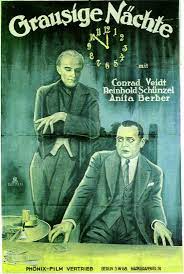
Portraits in a book store come to life after the store is closed. The three portraits, Death (Conrad Veidt), the Devil (Reinhold Schunzel) and the Prostitute (Anita Berber) amuse themselves by reading five stories of evil.
“The Apparition”: A man (Conrad Veidt) rescues a woman (Anita Berber) from the clutches of her ex-husband (Reinhold Schunzel) who has been stalking her. They both check into a hotel. She is on the first floor and he is on the third floor. The next day the man goes to the woman’s room and sees that it is completely different. The hotel staff tells him that he registered alone and denies that the woman ever existed.
“The Hand”: Two men (Conrad Veidt and Reinhold Schunzel) are vying for the same woman (Anita Berber). They throw dice to see who will get her. The loser kills the winner. Years later the killer sees the woman again and begins to be haunted by the claw-like hand of the man he killed.
“The Black Cat”: When a drunkard (Reinhold Schunzel) finds his wife (Anita Berber) flirting with another man (Conrad Veidt), he kills her and buries her body in the basement behind a wall. The woman’s cat gives him away.
“The Suicide Club”: A Man (Reinhold Schunzel) joins a secret society called The Suicide Club where the members decide who among them will be murdered via a game of cards. Whoever picks the ace of spades is the next victim. The man picks the ace of spades.
“The Spectre”: The bored wife (Anita Berber) of a Baron (Conrad Veidt) begins flirting with a nobleman (Reinhold Schunzel) who has had a carriage accident in front of the castle. The nobleman regales the Baroness with tales of his bravery. The Baron decides to bring the braggart philanderer down a peg.
“Eerie Tales” AKA “Unheimliche Geschichten” or “Uncanny Stories” was released in 1919 and was directed by Richard Oswald. It is a German silent horror omnibus portmanteau anthology consisting of five stories that are based on stories by Edgar Allan Poe, Robert Louis Stevenson, Anselm Hein, Robert Liebmann and Richard Oswald. Richard Oswald later remade the film again as “The Living Dead” 1932. Oswald also appears in the film. He is in the prologue with Veidt and Schunzel.
It is considered to be the first anthology film. Most of the stories have become standard in many anthologies but they were here first. I have seen a couple versions of some of them myself in other silent films. Poe’s “The Black Cat” has been done many times. The movie is a fun and eerie compilation of some tried and true tales. There are a few touches of what would become German Expressionistic cinema in a few years that add a macabre touch to the tales.
Conrad Veidt is one of Germany’s most well known actors. Tall dark and svelte he was the sleepwalker Cesare in “The Cabinet of Dr. Caligari” 1920. He also starred in “Hands of Orlac” 1924, “Waxworks” 1924 and “The Man Who Laughs” 1928. When talkies came along Veidt transitioned seamlessly. In one of his final films he played Major Heinrich Strasser in “Casablanca” 1942.
Bernhard Goetzke, who plays a guy at the séance in “The Hand” was also Prosecutor von Wenk in “Dr. Mabuse the Gambler” 1922 as well as other Fritz Lang films such as “Die Nibelungen: Kriemhild's Revenge” 1924 and “Destiny” 1921. He has a bit part here but later he acted in some of the most well known and important German silent films.

